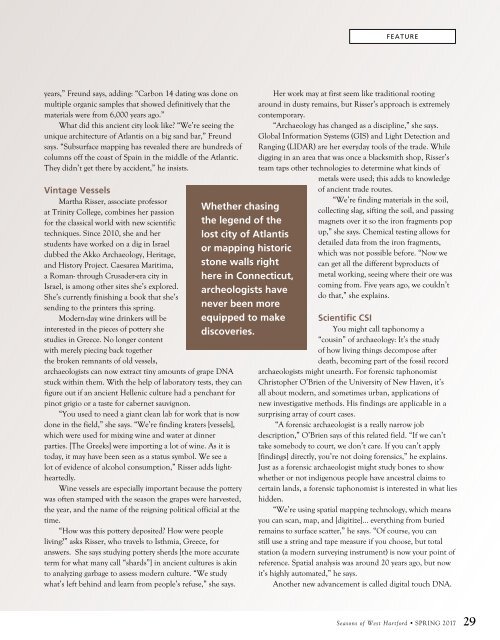You also want an ePaper? Increase the reach of your titles
YUMPU automatically turns print PDFs into web optimized ePapers that Google loves.
FEATURE<br />
years,” Freund says, adding: “Carbon 14 dating was done on<br />
multiple organic samples that showed definitively that the<br />
materials were from 6,000 years ago.”<br />
What did this ancient city look like? “We’re seeing the<br />
unique architecture of Atlantis on a big sand bar,” Freund<br />
says. “Subsurface mapping has revealed there are hundreds of<br />
columns off the coast of Spain in the middle of the Atlantic.<br />
They didn’t get there by accident,” he insists.<br />
Vintage Vessels<br />
Martha Risser, associate professor<br />
at Trinity College, combines her passion<br />
for the classical world with new scientific<br />
techniques. Since 2010, she and her<br />
students have worked on a dig in Israel<br />
dubbed the Akko Archaeology, Heritage,<br />
and History Project. Caesarea Maritima,<br />
a Roman- through Crusader-era city in<br />
Israel, is among other sites she’s explored.<br />
She’s currently finishing a book that she’s<br />
sending to the printers this spring.<br />
Modern-day wine drinkers will be<br />
interested in the pieces of pottery she<br />
studies in Greece. No longer content<br />
with merely piecing back together<br />
the broken remnants of old vessels,<br />
archaeologists can now extract tiny amounts of grape DNA<br />
stuck within them. With the help of laboratory tests, they can<br />
figure out if an ancient Hellenic culture had a penchant for<br />
pinot grigio or a taste for cabernet sauvignon.<br />
“You used to need a giant clean lab for work that is now<br />
done in the field,” she says. “We’re finding kraters [vessels],<br />
which were used for mixing wine and water at dinner<br />
parties. [The Greeks] were importing a lot of wine. As it is<br />
today, it may have been seen as a status symbol. We see a<br />
lot of evidence of alcohol consumption,” Risser adds lightheartedly.<br />
Wine vessels are especially important because the pottery<br />
was often stamped with the season the grapes were harvested,<br />
the year, and the name of the reigning political official at the<br />
time.<br />
“How was this pottery deposited? How were people<br />
living?” asks Risser, who travels to Isthmia, Greece, for<br />
answers. She says studying pottery sherds [the more accurate<br />
term for what many call “shards”] in ancient cultures is akin<br />
to analyzing garbage to assess modern culture. “We study<br />
what’s left behind and learn from people’s refuse,” she says.<br />
Whether chasing<br />
the legend of the<br />
lost city of Atlantis<br />
or mapping historic<br />
stone walls right<br />
here in Connecticut,<br />
archeologists have<br />
never been more<br />
equipped to make<br />
discoveries.<br />
Her work may at first seem like traditional rooting<br />
around in dusty remains, but Risser’s approach is extremely<br />
contemporary.<br />
“Archaeology has changed as a discipline,” she says.<br />
Global Information Systems (GIS) and Light Detection and<br />
Ranging (LIDAR) are her everyday tools of the trade. While<br />
digging in an area that was once a blacksmith shop, Risser’s<br />
team taps other technologies to determine what kinds of<br />
metals were used; this adds to knowledge<br />
of ancient trade routes.<br />
“We’re finding materials in the soil,<br />
collecting slag, sifting the soil, and passing<br />
magnets over it so the iron fragments pop<br />
up,” she says. Chemical testing allows for<br />
detailed data from the iron fragments,<br />
which was not possible before. “Now we<br />
can get all the different byproducts of<br />
metal working, seeing where their ore was<br />
coming from. Five years ago, we couldn’t<br />
do that,” she explains.<br />
Scientific CSI<br />
You might call taphonomy a<br />
“cousin” of archaeology: It’s the study<br />
of how living things decompose after<br />
death, becoming part of the fossil record<br />
archaeologists might unearth. For forensic taphonomist<br />
Christopher O’Brien of the University of New Haven, it’s<br />
all about modern, and sometimes urban, applications of<br />
new investigative methods. His findings are applicable in a<br />
surprising array of court cases.<br />
“A forensic archaeologist is a really narrow job<br />
description,” O’Brien says of this related field. “If we can’t<br />
take somebody to court, we don’t care. If you can’t apply<br />
[findings] directly, you’re not doing forensics,” he explains.<br />
Just as a forensic archaeologist might study bones to show<br />
whether or not indigenous people have ancestral claims to<br />
certain lands, a forensic taphonomist is interested in what lies<br />
hidden.<br />
“We’re using spatial mapping technology, which means<br />
you can scan, map, and [digitize]… everything from buried<br />
remains to surface scatter,” he says. “Of course, you can<br />
still use a string and tape measure if you choose, but total<br />
station (a modern surveying instrument) is now your point of<br />
reference. Spatial analysis was around 20 years ago, but now<br />
it’s highly automated,” he says.<br />
Another new advancement is called digital touch DNA.<br />
Seasons of West Hartford • SPRING 2017 29


